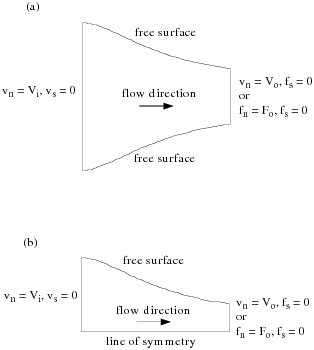A film flow problem is characterized by several nonlinearities. At first, the problem involves one or two free boundaries, as in Figure 18.1: Example of Flow Boundary Conditions for Film Casting, which introduce a coupling between the velocity and the coordinates. Additionally, Equation 18–4 couples the velocity to the film thickness.
Other nonlinearities can arise from the constitutive equations and the material data, such as shear-rate- or temperature-dependent viscosity. Nonlinearities can also be generated by the boundary conditions. This is especially true when the take-up velocity or force at the exit of the computational domain leads to strong changes in the geometry and/or in the thickness.
When the level of nonlinearity is significant, you should use an evolution scheme (for example, on the longitudinal extension ratio). See Evolution for information on evolution.



